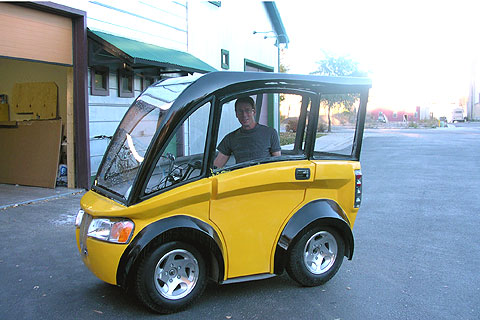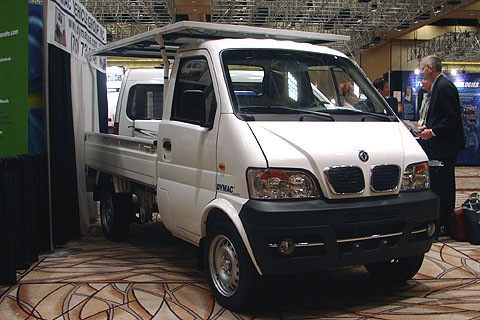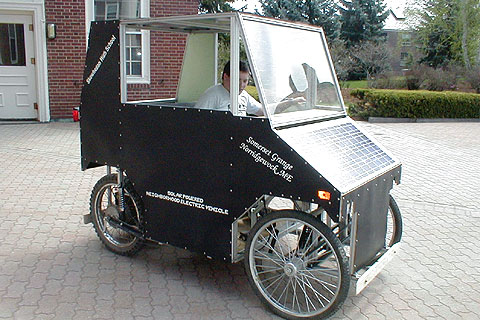
Solar panels fitted to a Dynmac utility truck.
Dynmac utility truck.Solar-powered cars have been pretty much confined to solar races and science projects until recently. However, there are several solar-powered neighborhood electric vehicles, or NEVs, on the market. Being classified as low-speed vehicles, their top speed is limited to 25 mph and, depending on the locale, their use is restricted to only certain roads.
Steve Titus, an electrical engineer in Bozeman, Montana, decided do something about energy conservation, the result is the Solar Bug. His company, Free Drive EV, builds the Solar Bug on an ATV (all terrain vehicle) chassis. It has an enclosed fiberglass body with tandem seating for two.
The roof-mounted solar panels provide 200 watts of power, sufficient for 10 to 20 miles daily. The remainder of the up-to-60-mile range between recharges comes from six 12-Volt lead acid AGM (Absorbed Glass Mat) batteries. Regenerative braking helps keep them recharged and there is an onboard charger, with a four to six hour recharging time.

The Solar Bug has great visibility and solar panels provide 10 to 20 miles of the Solar Bug’s 60 miles total range.
The SUNN Solar Car comes in kit formSince an ATV chassis is used, the driver and passenger straddle the seat and the handlebar is retained that also includes the throttle, hand lever for braking and lighting controls. For safety, there is a rollbar and seatbelts. The 300 pounds worth of batteries are located low in the chassis. This greatly lowers the center of gravity reducing the chance of tipping, or rolling over. A problem typical with ATVs. Titus has sold over 50 Solar Bugs priced at $15,000 each, and soon will begin delivering the first vehicles to people on his pre-order list.
Handy with tools? Well if so, the SUNN Solar Car comes as a kit. Its designer, Art Haines, says it can be assembled, and it takes between 80 and 120 man hours to construct. Since the square tube chassis comes already welded together, assembly requires only simple hand tools. The outside panels, floor and other body parts are made of fiberglass reinforced plastic.
If used without solar panels, you can drive for about 20 miles on the 12 Volt deep cycle marine batteries. Install solar panels and you will get 3 more miles from the 55-Watt panels mounted on the hood and another 12-16 miles per day from the 150 watt roof panels for a total of over 35 miles. There is regenerative braking and a built-in 120 Volt charger.

SUNN solar car.
Solar powered carThe two-passenger SUNN EV features four-wheel suspension with shock absorbers, rack and pinion steering, two-speed transmission with reverse and hydraulic disc brakes on all four wheels. It is street legal as a low speed vehicle (LSV) so the kit includes a windshield wiper, seat belts, horn, turn signals and lights. Safety glass windshield, doors and polycarbonate side and rear windows give weather protection. The company is located I Maine. The complete kit that costs $4,500 doesn’t include batteries or solar panels because they are heavy and costly to ship. There is both a coupe and pickup version.
The Dynmac Vehicle Group in Escondido, California offers a full line of off-road electric vehicles. Its pickups, cargo vans, and mini vans are based on small trucks from China that use AC or DC motors. Recently, it has developed a solar powered version by installing solar panels on a canopy over the bed of its pickup model. Now, if you start out with a fully charged battery, you can drive the truck ten miles and then let it sit in the sun for an hour. The battery will be back to full charge. Normally the Dymac trucks have a 30-mile range.




